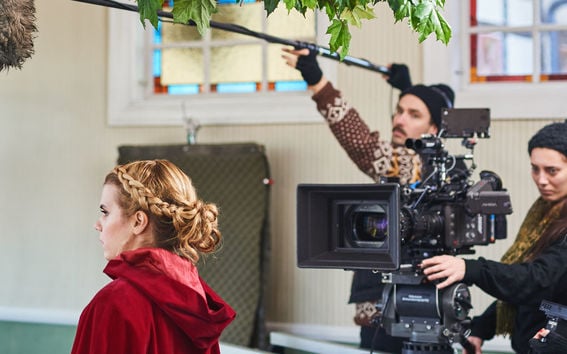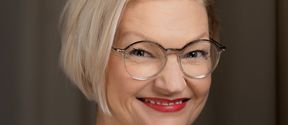‘Costume designers can add significant value to animated films’
I claim series: costume designer can have a key role in animations.

The Costume Design: Performing Arts and Film major of the Master’s Degree Programme in Film and Television focuses on the students’ personal development in artistic practice through creative enquiry and collaboration, theoretical and critical thinking. The studies emphasize the importance of personal time management and stress tolerance.
It aims at the students’ professional competence as costume designers in projects for screen and the performing arts. The studies are continuously enriched and updated by new design practices, new technologies and cutting-edge research in the field.
Students who graduate from the major in Costume Design: Performing Arts and Film (MA) are able to:
The language of instruction in the Master’s Programme in Film and Television is Finnish and English. However, in the major of Costume Design, a large part of the courses is taught in English. The degree can be completed in English.
The tuition fee for this programme is 20 000 euros per academic year. Citizens of European Union (EU), the European Economic Area (EEA) or Switzerland do not pay tuition fees. Citizens of other countries must pay tuition fees.
Aalto University offers a small number of scholarships in the form of tuition fee waivers to fee-paying students. Scholarships can be awarded to the highest-achieving applicants based on the programme's evaluation criteria. Applicants are ranked according to the criteria outlined on the programme's webpage.
More information on tuition fees and scholarships at Aalto University is available at the Scholarships and Tuition Fees webpage.
Master studies in Costume Design: Performing Arts and Film enhance the development of the students' artistic expression and conceptual thinking, and expand their creative, professional and technical skills and competency as visionary costume designers. The students have the possibility to experiment on advanced concepts for costume design in special areas of live performance, film, television, and other media, and to reflect and respond to artistically demanding productions through the design and creative processes of costume design.
The studies include entrepreneurial aspects, time and budget management skills, training in collaborative artistic work and in communicating ideas to a technical team. If interested, the students can focus on the history, theory and research of costume, and enrich their research skills. The learning is based on a practice-led research approach, where the students’ personal strengths and interests are taken into consideration in planning the content of the studies.
The studies are organised in collaboration with other majors from the Master’s Degree Programme in Film and Television and with the University of the Arts/Theatre Academy, as well as with external institutions, individual artists, and professional companies.
More information on the programme content and curriculum can be found in the Student guide.
Specialisation is built mainly through advanced studies, where students may choose courses.
The students are encouraged and supported to participate in international study exchanges and work placements abroad, as well as in major international events and projects such as exhibitions, festivals, and competitions. International visiting lecturers contribute frequently to the programme. The studies are also enriched and updated by the international mobility of the teaching and technical staff. The English language is predominantly used in teaching and supervision.
The programme provides good foundations to continue to doctoral studies. More information on the Aalto Doctoral Programme in Arts, Design and Architecture: Doctoral programmes.
Students are supported to plan their own future path from the beginning of the Master studies with personal study plans (PSP) and individual guidance, which continues during the courses and seminars. The interests and strengths of each student are encouraged and complemented with minor and optional studies. Each student is offered a possibility to focus on a specific area within the performing arts or the film and television professional field or any other performance context involving costume. The field of artistic practice for a costume designer is very broad and includes all kinds of live performance (theatre, opera, dance, circus, opening ceremonies and special events, and performance art), film, television and other screen and media projects, commercials and promotional events, festivals and celebrations. The structure of the studies in cooperation with other programmes and individuals provides a unique opportunity for networking and collaboration with professionals from other fields, opening the potential for new cooperation in the future. It is also possible to focus on the theory and research of the agency of costume in performance, and later undertake doctoral studies.
Costume designer, costume concept artist, costume supervisor, costume advisor, costume expert, teacher/educator in costume design, costume theorist, costume researcher, costume curator
The research in this programme is linked to several focus areas in the School of Arts, Design and Architecture. Additional information about research related to this programme can be found at the Department of Film website.
Aalto University and the departments involved in the programme collaborate with many high-quality universities worldwide.
The student can take advantage of the studies within other Aalto University Schools, studies within other universities as well as the major's international connections and student exchange possibilities.
The applicants are first evaluated based on Aalto’s general eligibility requirements. Applicants meeting the general eligibility criteria for master's studies are evaluated and ranked according to the evaluation criteria decided in advance for each study option.
The applications to the Master’s Programme in Film and Television - Costume Design: Performing Arts and Filmare evaluated based on the following criteria:
| Relevance of previous studies, phase 1 and 2 | |
| Assessed area | Content and quantity in relation to the applied study-option-specific requirements. |
|
Admission requirements |
The prerequisite for admission to the major in Costume Design: Performing Arts and Film is a bachelor’s degree in the same field or in a relevant field of study, or equivalent skills and knowledge. |
| Method of demonstrating competence |
Transcript(s) of records, degree certificate(s) |
| Artistic and/or design practice, phase 1 and 2 | |
| Assessed area | Demonstration of artistic experience in the field of costume design. |
|
Admission requirements |
Applicants present a portfolio that shows their artistic expression and design skills through costume sketches and/or production photographs. The portfolio must contain diverse samples of the applicant’s artistic and professional activity. The work contained in the portfolio must include full credits, listing the title/theme, type of project, year and place where the work was produced/presented, and the role of the applicant in the project. The applicant’s name, email and phone number and the degree programme applied for must be indicated on the portfolio cover. The portfolio should be in digital format uploaded as a single PDF file. |
| Method of demonstrating competence |
Portfolio (digital) |
| Other areas of competence, phase 1 and 2 | |
| Assessed area | Work experience and other acquired knowledge/achievements mentioned in the Curriculum Vitae (e.g. publications/articles, non-formal education, competitions, awards and grants, study trips, memberships) |
|
Admission requirements |
Applicants should demonstrate the range of their prior activity, work experience and other acquired knowledge related to costume design. Applicants are expected to demonstrate work experience in costume design in at least one of its areas of practice (theatre, film, television, opera, dance, commercials, etc. – for a complete list see the study option description). Other interests, achievements and experience are taken into consideration. |
| Method of demonstrating competence |
Curriculum vitae The study option does not consider recommendation letters. |
| Suitability, phase 1 and 2 | |
| Assessed area |
Applicant’s further suitability to the study option based on motivation, artistic visions and objectives, communication skills, and commitment for advanced studies. |
|
Admission requirements |
Applicants must write a motivation letter explaining the reasons for applying to the Costume Design: Performing Arts and Film major. The letter should explain the applicant’s personal strengths, areas of interest, artistic visions and objectives, teamwork experience, their learning goals, and their expectations and motivation for advanced studies. Maximum length of the motivation letter is 4000 characters excluding spaces (approx. one A4 page) |
| Method of demonstrating competence | Motivation letter |
| Academic performance, phase 1 and 2 | |
| Assessed area | Grades of the previous degree(s) and pace of studies |
| Admission requirements | The prerequisite for admission to the major in Costume Design is a bachelor’s degree in the same field or in a relevant field of study, or equivalent skills and knowledge. |
| Method of demonstrating competence | Transcript(s) of records, degree certificate(s) |
| Suitability, phase 2 | |
| Assessed area |
Applicant’s further suitability to the study option based on motivation, artistic visions and objectives, communication skills, and commitment for advanced studies. |
|
Admission requirements |
Applicants are invited to an interview in which they provide further insights regarding their motivation for applying to the Costume Design: Performing Arts and Film major, their particular interests in the field, their artistic visions and personal development objectives, their work experience and prior design work, their goals and expectations related to the MA studies in Costume Design, as well as their commitment plans for the studies. |
| Method of demonstrating competence |
Interview |
The selection process for those who meet the general eligibility criteria comprises of two phases:
In the first phase, students are evaluated based on their application materials according to the criteria listed below. In the second phase, the most suitable applicants are invited to an interview, from which a smaller subset of applicants will be offered a study place. Applicants accepted to the programme may be required to take supplementary studies.
Phase I
In Phase I, the applications are evaluated based on the following criteria
Only the applications who fulfill the requirements/are ranked highest in the preliminary evaluation will be invited to Phase II in the selection process.
Phase II
In Phase II, the evaluation is based on the following criteria
Final selection
The final selection decisions will be made based on the evaluation conducted in Phase II.
The documents required from all applicants are listed here (https://www.aalto.fi/en/study-at-aalto/applying-to-masters-programmes). In addition, applicants to this study-option are required to provide the following study-option-specific documents:
CV (Curriculum vitae)
The Curriculum Vitae (CV) should include the applicant’s work experience and other acquired knowledge or achievements related to costume design. Applicants are expected to demonstrate work experience in costume design in at least one of its areas of practice (theatre, film, television, opera, dance, commercials, etc. – for a complete list see the study option description). Other interests, achievements and experience are taken into consideration (e.g. publications/articles, non-formal education, competitions, awards and grants, study trips, memberships).
The study option does not consider recommendation letters.
Motivation letter
Applicants must write a motivation letter explaining the reasons for applying to the Costume Design: Performing Arts and Film major. The letter should explain the applicant’s personal strengths, areas of interest, artistic visions and objectives, teamwork experience, their learning goals, and their expectations and motivation for advanced studies. Maximum length of the motivation letter is 4000 characters excluding spaces (approx. one A4 page).
Portfolio (electronic)
Applicants present a portfolio that shows their artistic expression and design skills through costume sketches and/or production photographs. The portfolio must contain diverse samples of the applicant’s artistic and professional activity. The work contained in the portfolio must include full credits, listing the title/theme, type of project, year and place where the work was produced or presented, and the role of the applicant in the project. The applicant’s name, email and phone number and the degree programme applied for must be indicated on the portfolio cover.
The portfolio should be in digital format (electronic portfolio) and it should be uploaded as a single PDF-file onto the application system before submission of the application.
Maximum size for the portfolio is 1.0 GB. Name the file Portfolio-lastname-firstname.pdf.
Language of the application documents
The applicants are asked to send the abovementioned programme-specific documents preferably in English. The applicants also have the right to use Finnish or Swedish in the documents, if they wish.

I claim series: costume designer can have a key role in animations.

Our art-house short film festival presents seven tailor-made films on @aaltoarts Instagram.

Finland’s film industry is thriving and attracting new audiences at home and overseas. Where does the success come from?
Learning Services at the School of Arts, Design and Architecture
For enquiries regarding programme-specific application documents or studies in the programme, please contact Aalto ARTS Learning Services.
Admissions Services
For enquiries regarding the application process, obligatory application documents or English language proficiency, please contact Admissions Services.